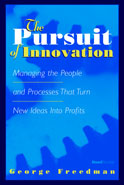|
|
|
|
||||||

|
The Pursuit of Innovation: Managing the People and Processes
That Turn New Ideas Into Profits
By George Freedman 2005/03 - Beard Books 1587982528 - Paperback - Reprint - 368 pp. US$34.95 A useful guide for implementing new ideas for increased revenues and profits. Publisher Comments
This book provides fascinating and useful direction for "effective innovation" -- the timely and efficient implementation of new ideas that results in significantly increased revenues and profits. Divided into four parts, the author offers valuable insight to and action for achieving successful outcomes. This book belongs on the reading and reference shelves of every person engaged in innovative endeavors and those who are interested in business success. From Rosabeth Moss Kanter, Professor, Harvard Business School: George Freedman, a master of innovation himself, has written a masterful book. His hands-on experience with new product development gives special credibility to the wisdom and insights in The Pursuit of Innovation. From Gifford Pinchot III, Chairman, Pinchot and Company: The Pursuit of Innovation is clear, pragmatic, and written from the heart. Anyone interested in new products will find it filled with useful insights. Read it! From Thomas C. MacAvoy, Vice Chairman, Corning: A very practical guide...George Freedman is a seasoned veteran. He covers all of the important issues... From Amazon: The book describes real-world, tested, ways to manage Innovation for business growth. It also explains the scientific approach for an Innovation program which the author has arrived at with his long experience in this field. These include: 1)The Idea 2)The Innovation concept report 3)The Feasibility model 4)The Engineering or Functional model 5)The Visual model 6)The Prototype 7)The Pilot production unit. The book also explains eight Innovation modes which include Innovation programs undertaken by the: Technical center Research Center New Products Center Captive R&D External Teams Internal Ventures Center External Ventures Center and Licensing Arrangements The book however does not give any direct solution to a particular problem, but it certainly exposes the reader to the real-world examples of some of the top corporations. These examples help the reader to get an insight into the efforts put in the success of an Innovation program. Conclusion: An excellent `Must read' book for all. Here one must realise that Innovation is an act of WILL. Doing it right against all odds. I think even non-conceivers can compensate for their lack of creative qualities by their WILL and that makes all the difference.
|
||||||||||||||||||||||||||||||||||||||||||||||||||||||||||||||||||||||||||||||||||||
|
|
|
home
| about us
| contact us
| related
sites |